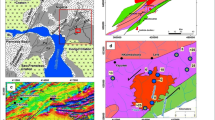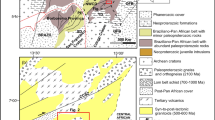Abstract
Electron-microprobe analyses and mineragraphic studies of native gold demonstrate considerable variations in the primary intergrain and intragrain distribution of silver. The gold grains have from 1–55 weight percent silver; copper is present in grains from only one locality and ranges from 0.1–0.6 weight percent. Some gold grains have strong zoning of silver whereas others have no detectable zoning. Gold grains from some deposits show remarkable intergrain homogeneity of silver and/or copper content, but others exhibit extreme heterogeneity. We believe that the inhomogeneities and variations in silver content recognized and emphasized here are features of primary deposition. We also recognize low-silver rims with sharp boundaries bordering many of the grains examined but believe these are developed in a relatively oxidizing, low-temperature environment and are not primary lode features. Opaque mineral inclusions of primary origin in gold grains are common in some deposits, scarce in many, and virtually absent from others. These inclusions may be of value in characterizing some gold deposits. For the majority of gold crystals from Copper Basin, Arizona, the lowest silver content observed was in the central portion of each grain and the highest silver content was in the rim. This is believed to be due an increase in the proportion of silver to gold in solution during growth of the crystals. Analysis of sized fractions of 331 gold grains from Pennsylvania Mountain, Colorado, shows no systematic correlation of grain size with silver content. Electron microprobe step-scanning of gold from Alder Gulch, Montana, suggests more than one mineralization event took place. Pyrite and acanthite inclusions less than 0.05 mm in the largest dimension, are present in some grains from this deposit. Inclusions of pyrite, pyrrhotite, chalcopyrite, and an isotropic Co-As-S mineral are present in the low-silver, copper-bearing gold from Ninemile Creek, Montana. The presence of copper and the low silver content in this gold is not typical of the gold-quartz-pyrite association which is common in the Western United States.
Zusammenfassung
Untersuchungen von Zusammensetzungen von Einzelkörnern und benachbarten Körnern mit der Mikrosonde und durch erzmikroskopische Studien an gediegenem Gold weisen beträchtliche Variationen in der primären Verteilung von Silber auf. Die Goldkörner enthalten von 1–55 Gewichtsprozent Silber; Kupfer ist gegenwärtig in Körnern von nur einer Gegend zwar in Mengen von 0,1–0,6 Gewichtsprozent. Manche Goldkörner sind stark zonar mit Silber während andere keine bemerkbaren Zonen aufweisen. Goldkörner aus einigen Ablagerungen zeigen eine bemerkenswerte Homogenität von Silberund/oder Kupfergehalt, andere aber sind durch extreme Inhomogenität gakennzeichnet. Wir glauben, daß die festgestellten Inhomogenitäten und Variationen des Silbergehaltes Merkmale von primären Ablagerungen sind. Zusätzlich wurden an vielen von den von uns untersuchten Körnern scharfbegrenzte Randzonen mit niedrigem Silbergehalt beobachtet. Wir glauben, daß sich die Randzonen in einer verhältnismäßig oxidierenden Umgebung von niedriger Temperatur entwickelten und daß sie nicht Merkmale primärer Erzadern sind. Opake Mineraleinschlüsse von primärem Ursprung in Goldkörnern kommen in manchen Ablagerungen vor, selten in vielen und sind virtuell abwesend in anderen. Für einige Goldablagerungen können diese Einschlüsse als charakteristische Kennzeichen von Wert sein. Der niedrigste Silbergehalt für die meisten Goldkristalle, aus dem Copper Basin, Arizona, war in der Mitte der Körner und der höchste Silbergehalt war in den Randzonen der Körner gegenwärtig. Es wird angenommen daß dieses auf eine Zunahme in den Proportionen von Silber zu Gold in der Lösung während des Wachstums der Kristalle zurückzuführen ist. Analysen von Größensortierungen von 331 Goldkörnern aus den Pennsylvania Mountain, Colorado, zeigen keine systematische Korrelation der Korngrößen mit den Silbergehalten. Mikrosonde — Scanninganalysen an Gold aus dem Alder Gulch, Montana, weisen auf mehr als einen Mineralisationsvorgang hin. Pyrit- und Akanthiteinschlüsse von weniger als 0,05 mm in den größten Dimensionen sind in einigen Körnern dieser Ablagerung enthalten. Einschlüsse von Pyrit, Pyrrhotin, Chalcopyrit und von einem isotropen Co-As-S-mineral finden sich in dem silberarmen, kupferhaltigen Gold von Ninemile Creek, Montana. Der Kupfergehalt und der niedrige Silbergehalt in diesem Gold sind nicht typisch für die in dem westlichen Teil der USA übliche Gold-Quarz-Pyrit Assoziation.
Similar content being viewed by others
References
Desborough, G. A.: Silver depletion indicated by microanalysis of gold from placer occurrences, Western United States. Econ. Geol. 65, 304–311 (1970).
— Raymond, W. H., Iagmin, P. J.: Distribution of silver and copper in placer gold derived from the northeastern part of the Colorado Mineral Belt. Econ. Geol. 65, 937–944 (1970).
-- -- Soule, Courtney: Placer gold of unique fineness in Douglas and Elbert Counties, Colorado. U.S. Geol. Survey Prof. Paper 700-D, D134–D139 (1970).
Fisher, N. H.: The fineness of gold, with special reference to the Morobe goldfield, New Guinea, Part II. Econ. Geol. 40, 537–563 (1945).
— Application for gold fineness to the search for ore. Australian Inst. Min. Met., Proc. 156–157, 185–190 (1950).
Goni, J., Guillemin, C., Sarcia, C.: Geochimié de l'or exogène. Étude expérimentale de la formation des dispersions colloídales d'or et de leur stabilité. Mineral. Deposita (Berl.) 1, 259–268 (1967).
Hausen, D. M., Kerr, P. F.: Fine gold occurrence at Carlin, Nevada. Ore deposits in the United States, 1933–1967, The Graton-Sales Volume. Am. Inst. Mining Met. Petrol. Eng., Inc., New York 1, 909–940 (1968).
Jones. R. S., Fleischer, M.: Gold in minerals and the composition of native gold. U.S. Geol. Surv. Circ. 612, 17 (1969).
Lyden, C. J.: The gold placers of Montana. Montana Bur. Mines Geol. Mem. 26, 151 (1948).
Ottemann, J., Augustithis, S. S.: Geochemistry and origin of “platinum-nuggests” in lateritic covers from ultrabasic rocks and birbirites of W. Ethiopia Mineral. Deposita (Berl.) 1, 269–277 (1967).
Saager, R.: The relationship of silver and gold in the Basal Reef of the Witwatersrand System, South Africa. Mineral. Deposita (Berl.) 4, 93–113 (1969).
Schidlowski, M.: The gold fraction of the Witwatersrand conglomerates from the Orange Free State goldfield (South Africa). Mineral. Deposita 3, 344–363 (1968).
Singewald, Q. D.: Gold placers and their geologic environment in northwestern Park County, Colorado. U.S. Geol. Surv., Bull. 955-D, 103–172 (1950).
— Butler, B. S.: Ore deposits in the vicinity of the London fault, Colorado. U.S. Geol. Surv., Bull. 911, 74 (1941).
Slaughter, A. L.: The Homestake mine. Ore deposits of the United States, 1933–1967 Graton-Sales Volume. Am. Inst. Mining Metal. Petrol. Eng., Inc., New York, 2, 1436–1459 (1968).
Smith, G. O.: Gold mining in central Washington: U.S. Geol. Surv., Bull. 213, 76–80 (1903).
Winchell, A. N.: The mining districts of the Dillon quadrangle, Montana, and adjacent areas: U.S. Geol. Surv., Bull. 574, 191 (1914).
Author information
Authors and Affiliations
Additional information
Publication authorized by the Director, U. S. Geological Survey.
Rights and permissions
About this article
Cite this article
Desborough, G.A., Heidel, R.H., Raymond, W.H. et al. Primary distribution of silver and copper in native gold from six deposits in the Western United States. Mineral. Deposita 6, 321–334 (1971). https://doi.org/10.1007/BF00201890
Received:
Issue Date:
DOI: https://doi.org/10.1007/BF00201890




